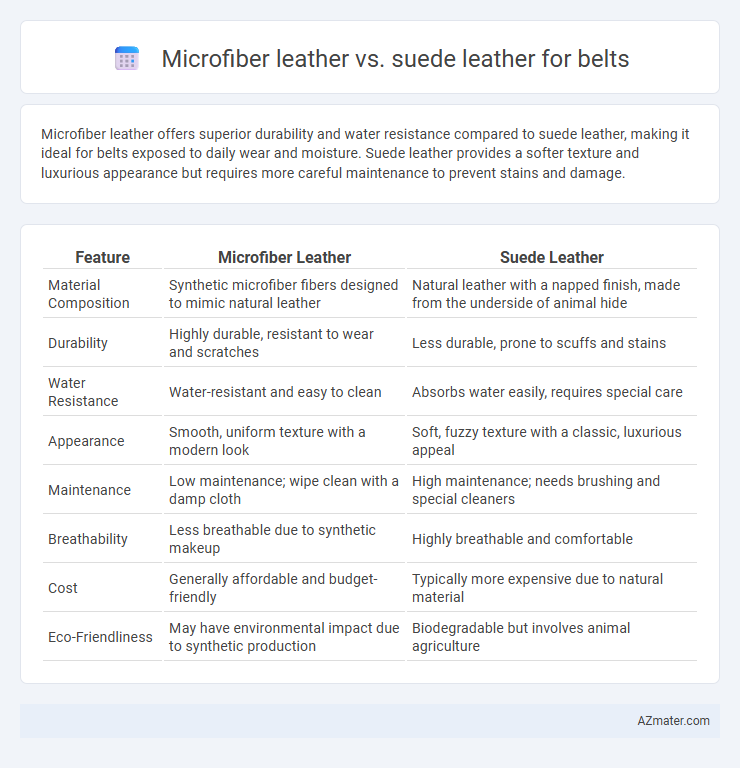Microfiber leather offers superior durability and water resistance compared to suede leather, making it ideal for belts exposed to daily wear and moisture. Suede leather provides a softer texture and luxurious appearance but requires more careful maintenance to prevent stains and damage.
Table of Comparison
| Feature | Microfiber Leather | Suede Leather |
|---|---|---|
| Material Composition | Synthetic microfiber fibers designed to mimic natural leather | Natural leather with a napped finish, made from the underside of animal hide |
| Durability | Highly durable, resistant to wear and scratches | Less durable, prone to scuffs and stains |
| Water Resistance | Water-resistant and easy to clean | Absorbs water easily, requires special care |
| Appearance | Smooth, uniform texture with a modern look | Soft, fuzzy texture with a classic, luxurious appeal |
| Maintenance | Low maintenance; wipe clean with a damp cloth | High maintenance; needs brushing and special cleaners |
| Breathability | Less breathable due to synthetic makeup | Highly breathable and comfortable |
| Cost | Generally affordable and budget-friendly | Typically more expensive due to natural material |
| Eco-Friendliness | May have environmental impact due to synthetic production | Biodegradable but involves animal agriculture |
Introduction to Microfiber Leather and Suede Leather
Microfiber leather is a synthetic material composed of ultra-fine fibers designed to mimic the texture and durability of natural leather while offering enhanced water resistance and easier maintenance. Suede leather, derived from the underside of animal hides, features a soft, napped finish known for its luxurious feel but requires careful handling due to its susceptibility to stains and moisture. When selecting a belt, microfiber leather provides a practical, long-lasting alternative, whereas suede leather emphasizes aesthetic appeal and a distinctive tactile experience.
Material Composition and Manufacturing Process
Microfiber leather for belts is composed of fine synthetic fibers tightly woven and coated with a polyurethane layer, creating a durable and water-resistant material that mimics genuine leather's texture. Suede leather originates from the underside of animal hides, primarily cowhide, processed through careful sanding or buffing to achieve its characteristic soft, fuzzy surface with a porous texture. The manufacturing of microfiber leather involves advanced textile engineering and chemical treatments to enhance flexibility and resistance, while suede production requires precise leather tanning and finishing techniques to preserve breathability and softness.
Appearance and Texture Comparison
Microfiber leather offers a smooth, uniform appearance with a consistent texture that mimics genuine leather, making belts look sleek and polished. Suede leather features a soft, napped finish with a velvety texture, providing a more casual and tactile feel. In terms of durability, microfiber leather resists stains and moisture better, while suede requires careful maintenance to preserve its delicate surface.
Durability and Longevity
Microfiber leather offers superior durability and resistance to water and stains compared to suede leather, making it an excellent choice for belts exposed to daily wear and varying conditions. Suede leather, while softer and more flexible, tends to absorb moisture and dirt, which can accelerate wear and reduce its longevity. For long-lasting belts, microfiber leather maintains its structure and appearance over time better than suede, contributing to extended belt life.
Comfort and Flexibility for Belts
Microfiber leather offers superior flexibility and stretch, adapting comfortably to waist movements without losing shape, making it ideal for everyday belts. Suede leather provides a soft, plush feel that enhances comfort but tends to be less flexible and more prone to creasing over time. The synthetic nature of microfiber leather also ensures enhanced durability and resistance to moisture compared to suede, which requires careful maintenance to retain its comfort qualities.
Maintenance and Cleaning Requirements
Microfiber leather requires minimal maintenance, as its synthetic fibers resist stains and water, making it easy to clean with a damp cloth and mild soap. Suede leather demands more careful upkeep due to its porous texture, needing regular brushing with a suede brush and protection with water and stain repellents to maintain its appearance. Choosing microfiber leather offers a low-maintenance option for belts, while suede leather requires consistent, gentle cleaning to preserve its soft, luxurious feel.
Eco-Friendliness and Sustainability
Microfiber leather offers higher eco-friendliness compared to suede leather due to its synthetic composition, which reduces reliance on animal hides and lowers environmental impact associated with livestock farming. Suede leather, derived from animal hides, involves significant resource use, including water, chemicals for tanning, and greenhouse gas emissions, making it less sustainable. Choosing microfiber leather for belts supports sustainability by minimizing ecological footprint and promoting cruelty-free alternatives.
Cost Comparison: Microfiber vs Suede
Microfiber leather belts typically cost 30-50% less than suede leather belts due to lower production expenses and synthetic material use. Suede leather belts involve higher costs because of the natural hide processing and quality finishing required. Cost efficiency makes microfiber leather a budget-friendly option without compromising on style for belts.
Style Versatility and Design Options
Microfiber leather offers greater style versatility and a wider range of design options compared to suede leather, due to its ability to mimic various textures and colors while maintaining durability. Suede leather, characterized by its soft, napped finish, delivers a more casual and classic aesthetic but is limited in color variety and finishes. For belts, microfiber leather enables intricate patterns and embossing, making it suitable for both formal and casual styles, whereas suede is often preferred for relaxed, vintage looks.
Choosing the Best Leather for Your Belt
Microfiber leather offers superior durability, stain resistance, and ease of maintenance compared to suede leather, making it ideal for belts used in everyday or outdoor activities. Suede leather provides a soft texture and rich aesthetic but requires careful handling and regular conditioning to maintain its appearance. Choosing the best leather for your belt depends on your lifestyle needs, whether prioritizing longevity and practicality or style and tactile appeal.

Infographic: Microfiber leather vs Suede leather for Belt
 azmater.com
azmater.com